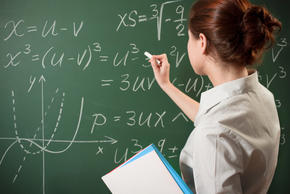
The term imaginary number often perplexes people because they incorrectly suppose that these numbers are not possible to compute. People puzzle over imaginary numbers, as a term, because they cannot readily conceive of how to calculate the square root of a negative number. In fact, when imaginary numbers were first named, they were believed to be theoretical, not real. Thus, they were called imaginary. In reality, these numbers do exist. They are often used in electrical engineering or with the construction of fractals. As teachers, we can help learners understand imaginary numbers by introducing these numbers in a way that demonstrates their prevalence in the real world.
Set Up Centers
As an educator, in order to provide real-world scenarios, I set up different centers for learners to move about freely and explore various applications of imaginary numbers. Centers are usually associated with elementary school children, but are not often used (or at least called centers) with high schoolers. However, it would be stimulating to have the following three centers offered for high school learners.
- An investigation table that showcases the theoretical/historical foundations of imaginary numbers.
- A lab, perhaps with computer simulations, of fractal applications of imaginary numbers.
- A center with the application of complex numbers to electrical circuits and electricity.
As an online project for learners, I suggest modifying the centers. Have three different pathways they could select from, but keeping the same categories as noted above.
Theoretical/Historical
One center (or pathway) would be a historical/theoretical avenue that explores imaginary and complex numbers. There would be one center replicating ancient Greco-Roman artifacts from Heron of Alexandria, who is on record as the first to dabble with complex numbers. It would also have Italian Renaissance mathematicians Gerolamo Cardono, who acknowledged their existence, and Rafael Bombelli, who, in 1572, formulated the properties of complex numbers. In addition, include Isaac Newton, who formulated with complex numbers. Such a display could be done through a historical contextualization as well as with artifacts that included specific calculations in connection to these concepts. This historical and mathematical center would invigorate high schoolers’ thinking. Another prompt within this approach may be to challenge learners to think of a more appropriate term for imaginary numbers. Perhaps you could have the class ponder other possible names. Students might have to logically and mathematically prove how their language is more fitting for renaming these concepts and possibly contemplate the philosophical implications that René Decartes may have developed with these figures.
Fractals
All fractals use complex numbers to generate their images. If certain software is available to use in the computer area of the classroom, pupils might explore how various formulas generate specific kinds of images. Arm your learners with access to fractal-generating software that discloses its iterating formulas.They could go on a fractal treasure hunt to find the equations for Julia Set, Mandelbrot, Sierpinski Triangle etc. Finally, in order to get everyone to see real-life applications of operations with complex numbers, the teacher may actually have each person perform an iteration showing his work and calculations and then reflect on how these same calculations are done by computers to display each pixel of the fractal. Additionally, fractals are not just nice to look at, they have a multitude of real-world applications to various kinds of designs and information storage. Learners could conduct further research using fractals in connection with technology and scientific standards.
Electrical Engineering
The group of teachers/graduate students with whom I collaborated this year, modified some problems that specifically used operations with complex numbers in association with electrical engineering. Ohms law and the equation for parallel circuits could be utilized with certain complex expressions to see further real-world applications.
Literary References for Independent Study of Imaginary Numbers
Teachers and scholars may also want to independently explore how authors use references to imaginary numbers within literary texts. In the 2003 mystery The Da Vinci Code, Robert Langdon calls Sophie Neveu a mathematical cryptographer who believes in the imaginary number “i” because it helps her break codes. In Isaac Asimov’s 1942 science-fiction story “The Imaginary,” Tan Porus relates the psychology of a squid with a formula that uses imaginary numbers: “…using imaginary quantities in psychological equations stretches my faith in science just a little bit. Square root of minus one!” The book Imaginary Numbers: An Anthology of Marvelous Mathematical Stories, Diversions, Poems, and Musings, bridges the gap between math/science and literature, including works from Italo Calvino, Lewis Carroll, Douglas Hofstadter, and Martin Gardner. One more worthwhile resource for interdisciplinary connections with imaginary numbers is Robert Musil’s 1906 expressionist novel The Confusions of Young Törless, which is sometimes credited with predicting WWI and the rise of Fascism. Young Törless becomes particularly intrigued with imaginary numbers both mathematically and philosophically. He says, “…but why shouldn’t you try to apply the operation of square root calculation to a negative number anyway? It can’t produce a real value, of course, and that’s why the result is called imaginary. It’s as if you were to say: someone always used to sit here, so let’s put out a chair for him today; and, even if he’s died in the meantime, let’s act as though he was going to turn up.” (Note: Musil’s novel is for mature, adult readers only.)
Here are some related lessons that might be used with complex numbers:
Complex Number Properties
Twelfth graders review the properties of real numbers and apply them to different types of systems. They experiment with complex numbers to see which properties apply to the system of complex numbers shown. Learners also demonstrate the geometric rotations illustrated.
Application of Complex Numbers
Youth apply operations with complex numbers to electrical circuit problems, real-world situations, utilizing TI-83 Graphing Calculators. They perform basic operations of addition, subtraction, division and multiplication with complex numbers to assimilate particular formulas.
Introduction to Fractals: Geometric Fractals
Class members study and observe the patterns made by the areas of the Sierpinski Triangle. They use the computer to draw two or three iterations to discover the number patterns. Learners complete worksheets based on geometric fractals.

